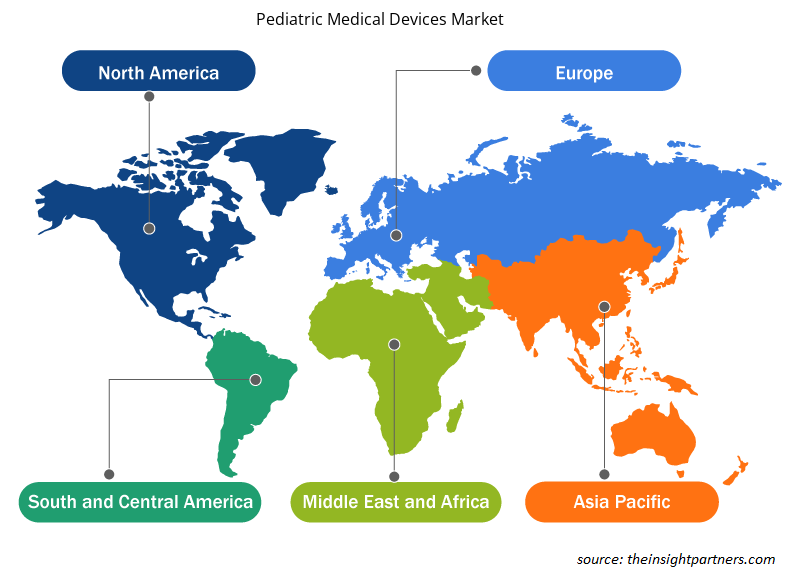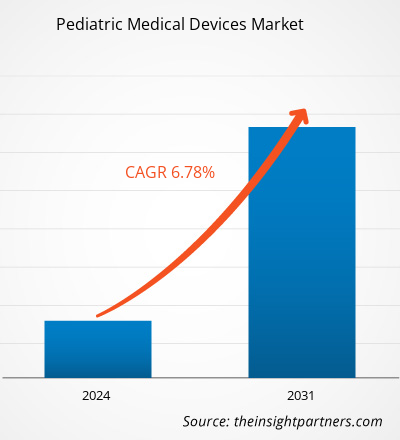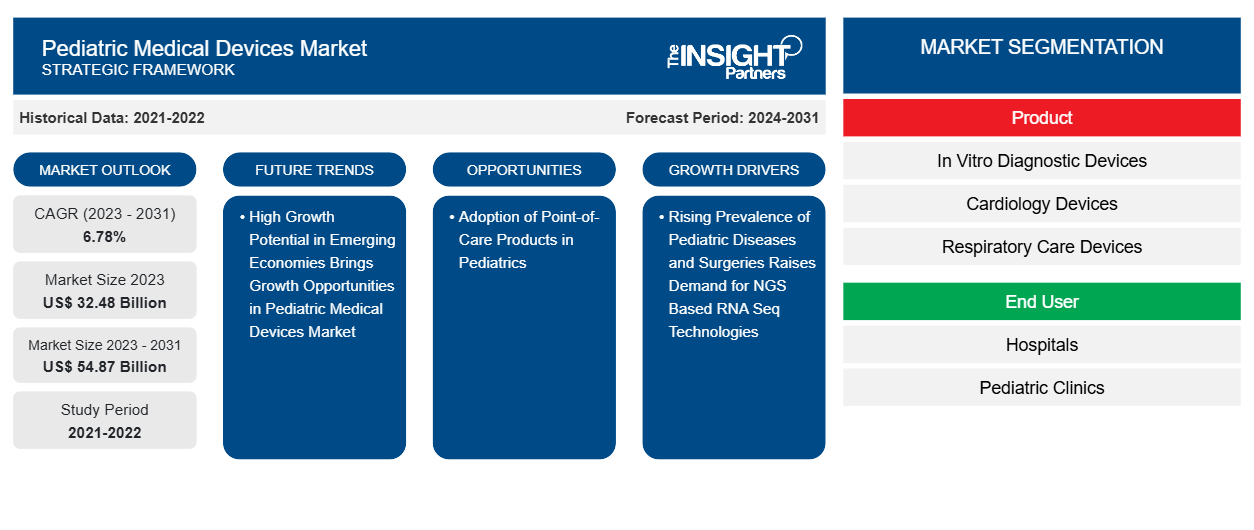Se proyecta que el tamaño del mercado de dispositivos médicos pediátricos alcance los 54.870 millones de dólares estadounidenses en 2031, frente a los 32.480 millones de dólares estadounidenses en 2023. Se espera que el mercado registre una CAGR del 6,78 % durante el período 2023-2031. Es probable que la creciente popularidad de los dispositivos Point-of-Care para la atención pediátrica siga siendo una tendencia clave en el mercado.
Análisis del mercado de dispositivos médicos pediátricos
Los dispositivos médicos pediátricos tratan o diagnostican afecciones en personas desde el nacimiento hasta los 21 años. Los pacientes pediátricos se definen como personas de 21 años o menos en el momento de su diagnóstico o tratamiento. Las subpoblaciones pediátricas se clasifican en neonatos (desde el nacimiento hasta los 28 días), bebés (desde los 29 días hasta menos de 2 años), niños (desde los 2 años hasta menos de 12 años) y adolescentes (desde los 12 hasta los 21 años). El aumento de las enfermedades crónicas entre la población pediátrica impulsa la demanda de dispositivos médicos pediátricos.
Descripción general del mercado de dispositivos médicos pediátricos
Según un artículo publicado en la biblioteca en línea de Wiley en agosto de 2020, en los EE. UU. se realizan anualmente 3,9 millones de cirugías en niños de entre 0 y 17 años. Los procedimientos quirúrgicos más comunes en la infancia, excluida la circuncisión, están relacionados con el oído, la nariz y la garganta: amigdalectomías, adenoidectomías y colocación de tubos de timpanostomía. El creciente número de cirugías pediátricas está aumentando la demanda de nuevas innovaciones en el mercado de dispositivos médicos pediátricos. Además, con la creciente demanda, las empresas están introduciendo nuevas tecnologías para acelerar el crecimiento de su participación en el mercado. Por ejemplo, en junio de 2021, Preceptis Medical, Inc., lanzó Hummingbird Tympanostomy Tube System (TTS), un sistema de tubos auditivos de última generación para procedimientos de miringotomía pediátrica en el consultorio. El nuevo dispositivo Hummingbird tiene un diseño ergonómico mejorado que hace que los procedimientos de timpanostomía en niños pequeños sean más exitosos sin anestesia general.
Personalice este informe según sus necesidades
Obtendrá personalización en cualquier informe, sin cargo, incluidas partes de este informe o análisis a nivel de país, paquete de datos de Excel, así como también grandes ofertas y descuentos para empresas emergentes y universidades.
-
Obtenga las principales tendencias clave del mercado de este informe.Esta muestra GRATUITA incluirá análisis de datos, desde tendencias del mercado hasta estimaciones y pronósticos.
Impulsores y oportunidades del mercado de dispositivos médicos pediátricos
El creciente número de cirugías pediátricas favorece el mercado
Como lo destaca el Fondo de las Naciones Unidas para la Infancia (UNICEF), la neumonía es la principal causa de muerte entre los niños menores de 5 años, lo que resulta en aproximadamente 700.000 muertes por año. Se espera que la creciente prevalencia de enfermedades crónicas, incluidas las enfermedades respiratorias, el cáncer y los trastornos cardiovasculares, impulse la demanda de dispositivos médicos pediátricos. La encefalopatía hipóxico-isquémica (EHI) es una de las principales causas de mortalidad y morbilidad neonatal en los bebés a término y casi a término. Con los avances en la atención neonatal, las tecnologías médicas han permitido la adopción de nuevas terapias para apoyar la atención o para explorarlas en grandes estudios clínicos. Como resultado, la creciente adopción de dispositivos médicos en los centros de atención pediátrica impulsa el mercado mundial de dispositivos médicos pediátricos.
El alto potencial de crecimiento en las economías emergentes genera oportunidades de crecimiento
Según un artículo publicado en BMJ Open en noviembre de 2022, un estudio realizado con datos de la Encuesta demográfica y de salud de 33 países del África subsahariana concluyó que las enfermedades infantiles comunes prevalecen entre los niños menores de 5 años en los países del África subsahariana. Los factores a nivel individual y comunitario están asociados con este problema. Además, la creciente infraestructura sanitaria en las economías emergentes y el creciente énfasis en la telemedicina ofrecen perspectivas prometedoras para la expansión del mercado. Por lo tanto, las iniciativas colectivas de las organizaciones internacionales, como la OMS y UNICEF en regiones como Asia Pacífico, Oriente Medio y África, fortalecen sus infraestructuras de atención sanitaria pediátrica creando conciencia sobre la seguridad pediátrica. Es probable que estas ofrezcan oportunidades lucrativas para el crecimiento del mercado de dispositivos médicos pediátricos durante el período de pronóstico.
Análisis de segmentación del informe de mercado de dispositivos médicos pediátricos
Los segmentos clave que contribuyeron a la derivación del análisis del mercado de dispositivos médicos pediátricos son el producto y el usuario final.
- El mercado de dispositivos médicos pediátricos está segmentado según el producto en dispositivos de diagnóstico in vitro (IVD), dispositivos de cardiología, dispositivos de atención respiratoria, dispositivos de monitoreo, dispositivos de UCI neonatal y otros. El segmento de dispositivos de diagnóstico in vitro (IVD) tuvo la mayor participación de mercado en 2023.
- Por usuario final, el mercado está segmentado en hospitales, clínicas pediátricas y otros. El segmento de hospitales tuvo la mayor participación del mercado en 2023.
Análisis de la cuota de mercado de dispositivos médicos pediátricos por geografía
El alcance geográfico del informe de mercado de dispositivos médicos pediátricos se divide principalmente en cinco regiones: América del Norte, Asia Pacífico, Europa, Medio Oriente y África, y América del Sur y Central. Se espera que Asia Pacífico crezca con la CAGR más alta en los próximos años.
El mercado de dispositivos médicos pediátricos en América del Norte se analiza en función de los tres países principales: Estados Unidos, Canadá y México. Se prevé que Estados Unidos tenga la mayor participación en el mercado de dispositivos médicos pediátricos de América del Norte en 2023.
Según la Academia Estadounidense de Pediatría, entre el 3% y el 4% de todos los bebés que nacen en los EE. UU. tienen anomalías congénitas. Según los Centros para el Control y la Prevención de Enfermedades (CDC), 1 de cada 33 bebés que nacen en los EE. UU. sufre defectos congénitos cada año. El aumento en la cantidad de poblaciones pediátricas que tienen deformidades congénitas refleja la mayor cantidad de poblaciones que se someten a tratamientos quirúrgicos. Por lo tanto, factores como la creciente carga de enfermedades pediátricas, las actividades de I+D para desarrollar dispositivos médicos pediátricos avanzados y el aumento de los lanzamientos de productos contribuyen al crecimiento de la participación de mercado de dispositivos médicos pediátricos en los EE. UU.
Perspectivas regionales del mercado de dispositivos médicos pediátricos
Los analistas de Insight Partners explicaron en detalle las tendencias y los factores regionales que influyen en el mercado de dispositivos médicos pediátricos durante el período de pronóstico. Esta sección también analiza los segmentos y la geografía del mercado de dispositivos médicos pediátricos en América del Norte, Europa, Asia Pacífico, Oriente Medio y África, y América del Sur y Central.

- Obtenga datos regionales específicos para el mercado de dispositivos médicos pediátricos
Alcance del informe de mercado de dispositivos médicos pediátricos
| Atributo del informe | Detalles |
|---|---|
| Tamaño del mercado en 2023 | US$ 32,48 mil millones |
| Tamaño del mercado en 2031 | US$ 54.87 mil millones |
| CAGR global (2023 - 2031) | 6,78% |
| Datos históricos | 2021-2022 |
| Período de pronóstico | 2024-2031 |
| Segmentos cubiertos |
Por producto
|
| Regiones y países cubiertos |
América del norte
|
| Líderes del mercado y perfiles de empresas clave |
|
Densidad de actores del mercado de dispositivos médicos pediátricos: comprensión de su impacto en la dinámica empresarial
El mercado de dispositivos médicos pediátricos está creciendo rápidamente, impulsado por la creciente demanda de los usuarios finales debido a factores como la evolución de las preferencias de los consumidores, los avances tecnológicos y una mayor conciencia de los beneficios del producto. A medida que aumenta la demanda, las empresas amplían sus ofertas, innovan para satisfacer las necesidades de los consumidores y aprovechan las tendencias emergentes, lo que impulsa aún más el crecimiento del mercado.
La densidad de actores del mercado se refiere a la distribución de las empresas o firmas que operan dentro de un mercado o industria en particular. Indica cuántos competidores (actores del mercado) están presentes en un espacio de mercado determinado en relación con su tamaño o valor total de mercado.
Las principales empresas que operan en el mercado de dispositivos médicos pediátricos son:
- F. Hoffmann-La Roche Ltd
- Compañía General Electric
- Corporación Médica Atom
- Philips NV, la línea Koninklijke
- Siemens AG
- Medtronic
Descargo de responsabilidad : Las empresas enumeradas anteriormente no están clasificadas en ningún orden particular.

- Obtenga una descripción general de los principales actores clave del mercado de dispositivos médicos pediátricos
Noticias y desarrollos recientes del mercado de dispositivos médicos pediátricos
El mercado de dispositivos médicos pediátricos se evalúa mediante la recopilación de datos cualitativos y cuantitativos de investigaciones primarias y secundarias, que incluyen publicaciones corporativas esenciales, datos de asociaciones y bases de datos. A continuación, se enumeran algunos de los desarrollos en el mercado de dispositivos médicos pediátricos:
- OrthoPediatrics Corp. ha firmado un acuerdo para adquirir Pega Medical, incluido su sistema intramedular telescópico Fassier-Duval diseñado para pacientes que padecen osteogénesis imperfecta y otras deformidades óseas. Su oferta de productos incluye tecnologías novedosas para tratar algunas de las afecciones más singulares de la ortopedia pediátrica. (Fuente: OrthoPediatrics Corp, comunicado de prensa, junio de 2022).
- LMT Medical Systems creó "Nomag IC Enhanced", una incubadora avanzada de diagnóstico por resonancia magnética que permite trasladar a los neonatos y bebés prematuros directamente de la UCIN a la sala de resonancia magnética para realizarles pruebas mediante imágenes por resonancia magnética óptimas y no invasivas. Durante el traslado y el examen por resonancia magnética, el bebé se encuentra protegido dentro de la incubadora de resonancia magnética que lo mantiene con vida y con temperatura y humedad controladas. (Fuente: Ergotron, comunicado de prensa, diciembre de 2020).
Informe sobre el mercado de dispositivos médicos pediátricos: cobertura y resultados
El informe “Tamaño y pronóstico del mercado de dispositivos médicos pediátricos (2021-2031)” proporciona un análisis detallado del mercado que cubre las siguientes áreas:
- Tamaño del mercado de dispositivos médicos pediátricos y pronóstico a nivel mundial, regional y nacional para todos los segmentos clave del mercado cubiertos bajo el alcance
- Tendencias del mercado de dispositivos médicos pediátricos, así como dinámicas del mercado, como impulsores, restricciones y oportunidades clave
- Análisis detallado de las cinco fuerzas de Porter y PEST y FODA
- Análisis del mercado de dispositivos médicos pediátricos que abarca las tendencias clave del mercado, el marco global y regional, los actores importantes, las regulaciones y los desarrollos recientes del mercado
- Panorama de la industria y análisis de la competencia que abarca la concentración del mercado, análisis de mapas de calor, actores destacados y desarrollos recientes en el mercado de dispositivos médicos pediátricos
- Perfiles detallados de empresas
- Análisis histórico (2 años), año base, pronóstico (7 años) con CAGR
- Análisis PEST y FODA
- Tamaño del mercado, valor/volumen: global, regional y nacional
- Industria y panorama competitivo
- Conjunto de datos de Excel
Informes recientes
Informes relacionados
Testimonios
Razón para comprar
- Toma de decisiones informada
- Comprensión de la dinámica del mercado
- Análisis competitivo
- Información sobre clientes
- Pronósticos del mercado
- Mitigación de riesgos
- Planificación estratégica
- Justificación de la inversión
- Identificación de mercados emergentes
- Mejora de las estrategias de marketing
- Impulso de la eficiencia operativa
- Alineación con las tendencias regulatorias























 Obtenga una muestra gratuita para - Mercado de dispositivos médicos pediátricos
Obtenga una muestra gratuita para - Mercado de dispositivos médicos pediátricos